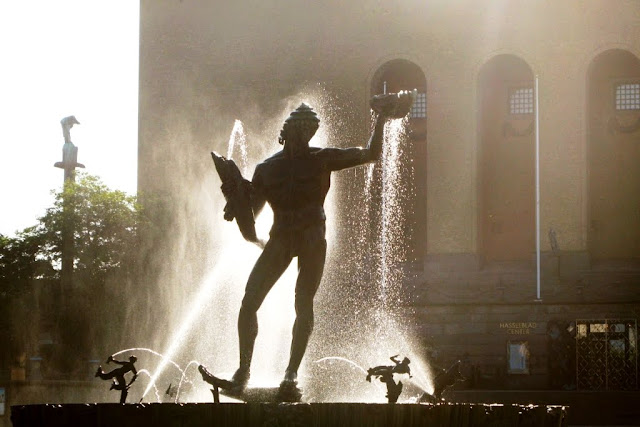As mentioned in my previous post, I decided to stay in my area (Batignolles, Paris 17) during the Heritage Days, hoping to avoid the longest queues. I was a bit curious about the freemasonry and took the opportunity to visit the “Grand Loge de France” (rue Puteaux). As you can see, I could not quite avoid the queuing and it took a small hour to get in.
The building dates from the end of the 19th century and was first a monastery, then, after the separation of the State and the Church in 1905, a cabaret, until the freemasons bought the building in 1910. During WW II, the building was confiscated by the occupants.
The visit was very well organised and we got some very qualified guides who took us through the library, the “temples” (a smaller one and a bigger one, the old monastery chapel having been cut in two) and some other places.
We got thus some qualified explanations of the freemasonry movement and I also read through a bit of documentation. I’m not a freemason and had everything to learn. Maybe some of you would be interested to learn a bit of what I have gathered?
The origin of the freemasons is rather unclear. There are different tendencies linking it to some very ancient traditions, but you may conclude that there are links to guilds (or lodges) of the Middle Ages and possibly also to the Knight Templars who were executed or fled to Scotland around 1300. The word “free mason” may be linked to “franc maçon” (masons, church builders, who were free of taxation). The freemasons pretended to be builders, not of churches, but of more moral issues.
The foundation of today’s masonry rules seems to have its origins from 1717 – in London – and the constitution rules were published by a Scotsman, James Anderson, in 1723. One of the (two?) still existing copies of this document was shown during our visit.
Freemasons have played significant roles in society during especially the 18th, 19th and beginning of the 20th centuries, basically in favour of the Revolutions, in the separation of Church and State, against fascism...
There have been and are today different tendencies of freemasonry, of more traditional obedience (ancients or “antients”) or referring to a more “modern” version. There is a certain separation between the Anglo-Saxon / American lodges and the European ones (often referred to as “orients”). Some are more neutral, like the one I visited, “Grand Loge de France”.
Today most lodges pretend to be in favour of free thinking, are not religious or clearly political, just open to free discussion and personal development, interpreting their mason symbols....
There seem totally to be some 5 million adherents in the world, whereof some 2 millions in the US and some 150 thousand in France, the biggest one, “Grand Orient de France” having some 47 thousand, the “Grand Loge de France” some 28 thousand.
I found a list of famous freemasons, which include most US presidents, until Gerald Ford and also an impressive list of personalities like: Christopher Wren, Bartholdi (Statue of Liberty), Eiffel, Chagall, Mucha, Citroën, J-H Dunant (Red Cross), Churchill, Conan Doyle, Goethe, Kipling, Walter Scott, Jonathan Swift, Oscar Wilde, PG Woodhouse, Nelson, Wellington, Alexander Fleming (penicillin), Bach, Beethoven, Haydn, Liszt, Mozart, Schiller, Darwin, Allende, Bolivar, Garibaldi, King George VI, Napoleon, Franklin, La Fayette, Buffalo Bill (Cody), David Crocket, Henry Ford, Gilette, Hoover, DeMille, Al Johnson, Harpo Marx, John Wayne, Mark Twain, McArthur, Irving Berlin, Count Basie, Nat King Cole, Duke Ellington, Oscar Peterson, Fats Waller, Jack Dempsey, Arnold Palmer...
 Anne of Austria was the wife of Louis XIII. When she after 23 years of marriage – at the age of 36 - at last gave birth to child, a son, the future Louis XIV, she decided in gratitude to build a chapel as part of a Benedictine convent she had previously founded. It seems that the seven year old son laid the cornerstone in 1645. The Val-de-Grâce church stood ready in 1667. One of the two architects was François Mansart. The roof painting is by Pierre Mignard (who gave the name to “mignardise” – a French word for delicacy), close friend of Molière. He later became “first painter” of the Royal court.
Anne of Austria was the wife of Louis XIII. When she after 23 years of marriage – at the age of 36 - at last gave birth to child, a son, the future Louis XIV, she decided in gratitude to build a chapel as part of a Benedictine convent she had previously founded. It seems that the seven year old son laid the cornerstone in 1645. The Val-de-Grâce church stood ready in 1667. One of the two architects was François Mansart. The roof painting is by Pierre Mignard (who gave the name to “mignardise” – a French word for delicacy), close friend of Molière. He later became “first painter” of the Royal court.




















































